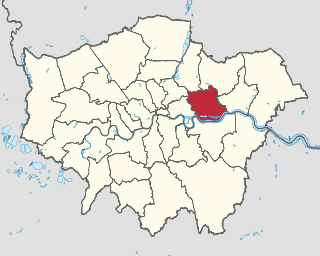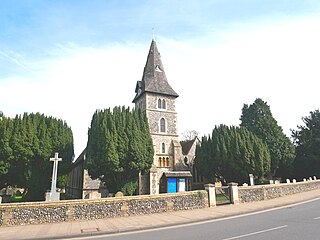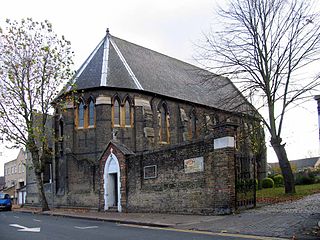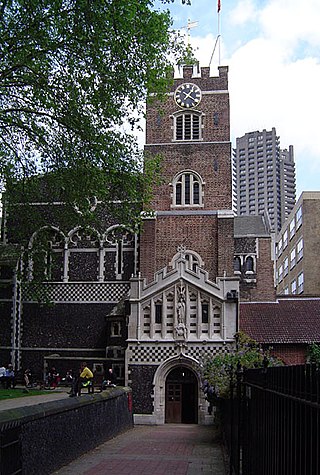
The London Borough of Newham is a London borough created in 1965 by the London Government Act 1963. It covers an area previously administered by the Essex county boroughs of West Ham and East Ham, authorities that were both abolished by the same act. The name Newham reflects its creation and combines the compass points of the old borough names. Situated in the Inner London part of East London, Newham has a population of 387,576, which is the third highest of the London boroughs and also makes it the 16th most populous district in England. The local authority is Newham London Borough Council.

Donhead St Mary is a village and civil parish in southwest Wiltshire, England, on the county border with Dorset. The village lies about 2+1⁄2 miles (4.0 km) east of the Dorset town of Shaftesbury and stands on high ground above the River Nadder, which rises in the parish.

Hambledon is a small village and civil parish in the county of Hampshire in England, situated about 10 miles (16 km) north of Portsmouth within the South Downs National Park.

St. Bartholomew-by-the-Exchange was a church and parish in the City of London located on Bartholomew Lane, off Threadneedle Street. Recorded since the 13th century, the church was destroyed in the Great Fire of London in 1666, then rebuilt by Sir Christopher Wren. The rebuilt church was demolished in 1840.

Brightwell Baldwin is a village and civil parish in Oxfordshire, about 4+1⁄2 miles (7 km) northeast of Wallingford. It was historically in the Hundred of Ewelme and is now in the District of South Oxfordshire. The 2011 Census recorded the parish's population as 208. The parish is roughly rectangular, about 2+1⁄2 miles (4 km) long north–south and about 1+1⁄4 miles (2 km) wide east–west. In 1848 the parish covered an area of 1,569 acres (635 ha). The B4009 road linking Benson and Watlington forms part of the southern boundary of the parish. The B480 road linking Oxford and Watlington forms a small part of its northern boundary. Rumbolds Lane forms much of its western boundary. For the remainder the parish is bounded largely by field boundaries.

St Bartholomew's Church is in the town of Great Harwood in Lancashire, England. It is an active Anglican parish church in the Diocese of Blackburn. The church is recorded in the National Heritage List for England as a designated Grade II* listed building.

St Mary the Virgin is a Gothic church in South London, built in the 12th century but with notable Gothic Revival modifications and additions in the mid-Victorian period to the designs of Sir George Gilbert Scott and his son John Oldrid Scott. It is dedicated to St Mary the Virgin. In its present form, this church is a hall church with an aisled nave of three vessels of similar heights under three parallel roofs

St Philip and St James’ Church is a Church of England church in Plaistow, east London. It originated as two churches before being merged into the joint parish of St Philip and St James in 1955. That parish in its turn has now become part of the Parish of the Divine Compassion along with three other parishes in Plaistow and Canning Town - St Mary's, St Matthias' and St Martin's.

St Mary Magdalene's Church, East Ham is a parish church in East Ham, east London, dedicated to St Mary Magdalene. Its nave, chancel and apse date to the first half of the 12th century and the tower probably to the early 13th century but partly rebuilt in the 16th century - it is claimed to be the oldest parish church still in weekly use in Greater London and is listed at Grade I.

St Paul's Church, East Ham or St Paul's Church, Burges Road is a Church of England parish church in East Ham, Newham, east London.
St John the Baptist's Church, East Ham, was a Church of England church dedicated to St John the Baptist in East Ham, east London. It was built in 1866 as a chapel of ease to St Mary Magdalene's Church, then still the main parish church for the area. In 1902 it was converted into a church hall for the new church of St Bartholomew's and in 1925 it was demolished.

St George and St Ethelbert's Church, East Ham, is a Church of England church in East Ham, east London.

St Edmund's Church, Forest Gate or the Church of St Edmund, King and Martyr, Forest Gate is an Anglo-Catholic church in the Forest Gate area of Newham, east London. It is dedicated to Edmund the Martyr. It originated in 1895 as the Red Post Lane mission district of All Saints parish. It became a parish of its own in 1901, with a permanent church completed in 1932. It now forms part of the East Ham Team Parish alongside St Mary Magdalene's Church, St Bartholomew's Church and St Alban's Church.
St Stephen's Church, East Ham, was a church on Green Street in East Ham, east London. Its nave and aisles were completed in 1887 and its chancel, north chapel, south chancel aisle, vestries and choir in 1894. It founded three mission churches - St Alban's Church, St Michael's Church, Rutland Road and St Cuthbert's Church, Florence Road.
St Alban's Church, Upton Park is a Church of England church in the Upton Park area of East Ham in east London, England, dedicated to Saint Alban. It was founded by St Stephen's Church as a mission church on Boleyn Road in the Upton Park area around 1889, replaced by a small brick church on Wakefield Street in 1897. It was given a parish of its own in 1903, in which year the nave and aisle of a new permanent church on the opposite side of the same street were completed. Vestries, a Lady Chapel and chancel were added in 1934. Damaged by the London Blitz in 1940, it was repaired in 1949 and now forms part of the East Ham Team Parish alongside St Mary Magdalene's Church, St Bartholomew's Church and St Edmund's Church.
St Michael's Church, Rutland Road is a church in East Ham, east London, originally built for the Church of England. It was established as a mission church of St Stephen's Church, East Ham in 1895, with services held in Saxby Villas, Red Post Lane until the completion of a temporary iron church in 1898. In 1912 a permanent church was built. This housed the congregation of St Stephen's after that church was damaged by bombing in 1940 and after that parish was dissolved in 1953 St Michael's was instead attached to St Edmund's Church. It closed as an Anglican church in 1971 and now houses a Romanian Orthodox church.

St Andrew's Church was a Church of England church on Barking Road in Plaistow, east London. It began as a small mission built in 1860 on Whitwell Road by St Mary's Church, Plaistow. A permanent church designed by James Brooks opened in 1870 on a site just south of the northern outfall sewer embankment and a separate parish assigned to it the following year. A large central crossing tower with a pyramidal spire was planned but only completed as far as the ridge of the nave roof.
St Saviour's Church is a Church of England church in Forest Gate, east London. It was opened by Emmanuel Church, Forest Gate as a mission hall in 1880, with a separate parish and a permanent church following three years later. Its first vicar was Henderson Burnside, one of the first Anglican missionaries in Japan. It opened a mission at "365 Railway Arches" in 1903. Its parish is now known as 'St Saviour's and St James's, Forest Gate' after the area formerly forming the parish of St James' Church, Forest Gate was transferred to it in 2014 - the congregation from St James', however, transferred to St Paul's Church, Stratford, also in 2014.

St Nicholas' Chapel, Manor Park is a Roman Catholic church in Manor Park, East London.















